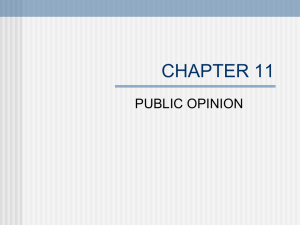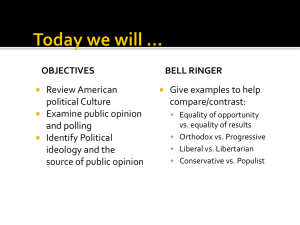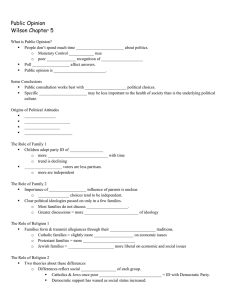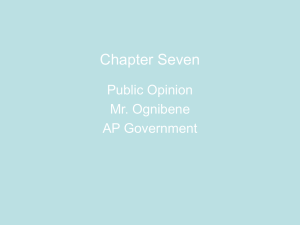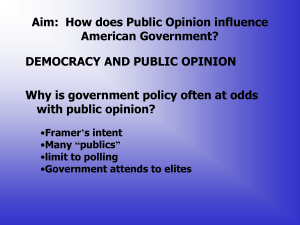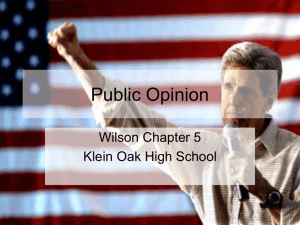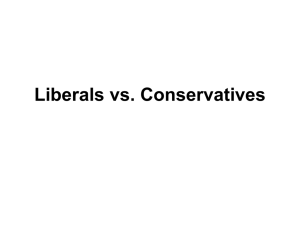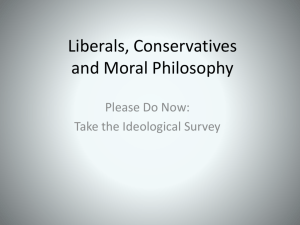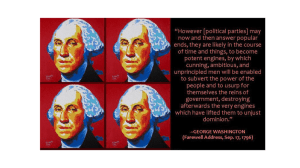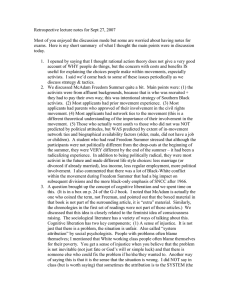PPT Public Opinion
advertisement
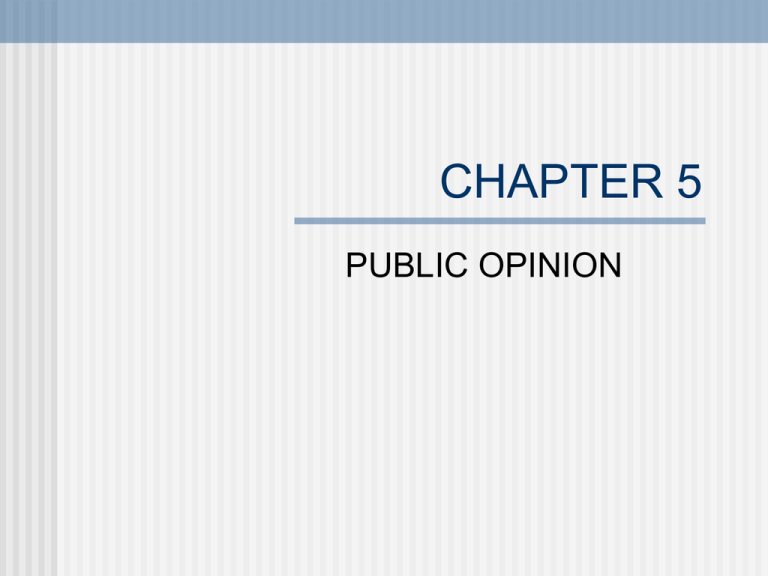
CHAPTER 5 PUBLIC OPINION WHAT IS PUBLIC OPINION Collective view of a group of people. Tends to be uninformed, unstable and can change rapidly. Americans do not spend a great deal of time thinking about politics. What makes a good poll? Random sampling Large sample size Front loaded questions. Stratified quota sample is the best. The way a question is asked can affect the answers given. Origins of Political Attitudes There are many factors that affect your political attitudes. They include: 1) family 2) religion 3) gender 4) schooling 5) occupation Role of the Family Party identification of family is usually absorbed, although the child becomes more independentthinking over time. 60% of children still follow parents- declining from previous years. Younger voters tend to be non-partisan; they register independent. Clear political ideologies are only passed on in a few families. Role of Religion Families form and transmit political beliefs through their religious traditions. Protestants tend to be more conservative. Jewish families tend to be more liberal. Christian Coalition- Republican affiliation, was once very powerful grassroots organization The Gender Gap The gender gap refers to the differences in political opinion between men & women. They have very different views on what they deem as important. This did not exist when women 1st voted, due to the fact that they followed their husband’s ideology/voting patterns. Gender Gap Trends Men have become increasingly more Republican since the 1960s. Women have continued to support the Democratic party at the same rate. These trends exist due to attitudinal differences between men & women about the size of government, gun control, social programs & gay marriage. Gender gap is NOT unique to the United States. Schooling & Information College has a liberalizing effect, because it teaches you to question authority. Professors in most colleges tend to be more liberal in nature. A conservative movement has sprouted on many campuses, but overall college students tend to be more liberal. Cleavages in Public Opinion A cleavage causes a division amongst ideological lines for citizens about certain topics. Examples include race, ethnicity, religion, occupation, age, experience,social class, etc. Some cleavages cause more passionate responses from citizens. You, as a citizen, must prioritize your cleavages as they sometimes conflict. (called cross-cutting cleavages). Social Class Social class has become much less of an issue in the United States. The main reason is COLLEGE- the great equalizer of the social classes. Race and Ethnicity Blacks tend to be more Democrat, although many younger blacks are now starting to identify themselves with the Republican party (1 out of every 4). Mexicans tend to be Democrats. Cubans tend to be Republicans. Asians tend to be Republicans. Region Political views today are less regionally distinct than they have ever been. That being said, most states do have a fairly consistent track record of voting for the same party on a fairly consistent basis. The South (specifically white southerners) have been the group that has change most dramatically in the last century. Political Ideology Definition- coherent and consistent set of political beliefs about the proper purpose and scope of government. Ideology is measured by how frequently and consistent someone is over time with their policy preferences. Liberalism and conservatism Early 1800s liberals supported personal and economic freedom; conservatives wanted power in the state, church and aristocracy. FDR- New Deal- changed the meaning of liberalism to mean support for an activist government. Conservatives (Goldwater)- favored free market, states’ rights, & economic freedom. Today’s meanings are less precise. Mixing Liberals & Conservatives Pure Liberals- Liberal on economic and social issues (17% of population) Pure Conservative- conservative on economic and social issues (28%) Libertarians- conservative on economic issues, liberal on social issues (21%) Populists- liberal on economic issues, conservative on social issues (24%) Political Elites Definition- those who have a disproportionate amount of some valued resource. (better information). Political elites exist in all societies. Elites display greater ideological consistency & tend to be more active. How Elites influence policy Elites influence public opinion in two ways: 1) Raise and frame issues. 2) State the norms by which to settle issues and define policy options. They struggle to define economic, crime, or other issues rooted in personal experience. Politicians tend to follow polling numbers on these issues. The “New Class”? Definition- those who are advantaged by power, resources, and growth of government. Qualities include: postgraduate education, urban, critical of business, liberal on social issues. Usually Democrat.
